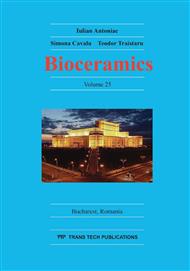[1]
B.R. Constantz, I.C. Ison, M.T. Fulmer, R.D. Poser, S.T. Smith, M. Van Wagoner, J. Ross, S.A. Goldstein, J.B. Jupiter, D.I. Rosenthal, Skeletal repair by in situ formation of the mineral phase of bone, Science 267 (1995) 1796–9.
DOI: 10.1126/science.7892603
Google Scholar
[2]
S.V. Dorozhkin, Bioceramics of calcium orthophosphates, Biomaterials 31 (2010) 1465-85.
DOI: 10.1016/j.biomaterials.2009.11.050
Google Scholar
[3]
S. Hesaraki, M. Safari, M.A. Shokrgozar, Development of beta-tricalcium phosphate/sol-gel derived bioactive glass composites: physical, mechanical, and in vitro biological evaluations, J. Biomed. Mater. Res. B Appl. Biomater. 91 (2009) 459-69.
DOI: 10.1002/jbm.b.31422
Google Scholar
[4]
R.P. del Real , J.G. Wolke , M. Vallet-Regí , J.A. Jansen, A new method to produce macropores in calcium phosphate cements, Biomaterials. 23 (2002) 3673-80.
DOI: 10.1016/s0142-9612(02)00101-1
Google Scholar
[5]
A. Sionkowska, J. Kozłowska, Properties and modification of porous 3-D collagen/hydroxyapatite composites, Int. J. Biol. Macromol. 52 (2013) 250-9.
DOI: 10.1016/j.ijbiomac.2012.10.002
Google Scholar
[6]
M.S. Laranjeira, M.H. Fernandes , F.J. Monteiro, Innovative macroporous granules of nanostructured-hydroxyapatite agglomerates: bioactivity and osteoblast-like cell behavior, J. Biomed. Mater. Res. A. 95 (2010) 891-900.
DOI: 10.1002/jbm.a.32916
Google Scholar
[7]
M. M. Pereira, J. R. Jones, and L. L. Hench, Bioactive glass and hybrid scaffolds prepared by sol–gel method for bone tissue engineering, Adv. Appl. Ceram. 104 (2005) 35-42.
DOI: 10.1179/174367605225011034
Google Scholar
[8]
A. R. Boccaccini, F. Chicatun, J. Cho, O. Bretcanu, J. A. Roether, S. Novak, and Q. Chen, Carbon nanotube coatings on bioglass‐based tissue engineering scaffolds, Adv. Functio. Mater. 17 (2007) 2815-2822.
DOI: 10.1002/adfm.200600887
Google Scholar
[9]
Q. Fu., M. N. Rahaman, B. Sonny Bal, R. F. Brown, D. E. Day, Mechanical and in vitro performance of 13–93 bioactive glass scaffolds prepared by a polymer foam replication technique, Acta biomater. 4 (2008) 1854-1864.
DOI: 10.1016/j.actbio.2008.04.019
Google Scholar
[10]
T. Kokubo, S. Ito, Z. Huang, T. Hayashi, S. Sakka, T. Kitsugi, and T. Yamamuro, Ca, P‐rich layer formed on high‐strength bioactive glass‐ceramic A‐W, J. Biomed. Mater. Res. 24 (1990) 331-343.
DOI: 10.1002/jbm.820240306
Google Scholar
[11]
B. Kundu, A. Lemos, C. Soundrapandian, P. Sen, S. Datta, J. Ferreira, and D. Basu, Development of porous HAp and β-TCP scaffolds by starch consolidation with foaming method and drug-chitosan bilayered scaffold based drug delivery system, J. Mater Sci. Mater. Med. 21 (2010).
DOI: 10.1007/s10856-010-4127-0
Google Scholar
[12]
S. Hesaraki, F. Moztarzadeh, D. Sharifi, Formation of interconnected macropores in apatitic calcium phosphate bone cement with the use of an effervescent additive. J. Biomed. Mater. Res. A 83 (2007)80-7.
DOI: 10.1002/jbm.a.31196
Google Scholar
[13]
T. Kokubo, H. Kushitani, S. Sakka, T. Kitsugi, T.J. Yamamuro. Solutions able to reproduce in vivo surface-structure changes in bioactive glass-ceramic A-W. J. Biomed. Mater. Res. 24 (1990) 721–734.
DOI: 10.1002/jbm.820240607
Google Scholar
[14]
S. Hesaraki, H. Nazarian, M. Pourbaghi-Masouleh, S. Borhan, Comparative study of mesenchymal stem cells osteogenic differentiation on low-temperature biomineralized nanocrystalline carbonated hydroxyapatite and sintered hydroxyapatite. J. Biomed. Mater. Res. B Appl. Biomater. 2013, doi: 10. 1002/jbm. b. 32987.
DOI: 10.1002/jbm.b.32987
Google Scholar
[15]
M. Bohner , U. Gbureck , J.E. Barralet . Technological issues for the development of more efficient calcium phosphate bone cements: a critical assessment. Biomaterials. 26 (2005) 6423-9.
DOI: 10.1016/j.biomaterials.2005.03.049
Google Scholar
[16]
S. Devile. Freeze-Casting of Porous Ceramics: A Review of Current Achievements andIssues. Adv. Eng. Mater. 10 (2008) 155-169.
DOI: 10.1002/adem.200700270
Google Scholar
[17]
T. W. Bauer, G. F. Muschler. Bone graft materials. An overview of the basic science. Clin Orthop Relat Res, 371 (2000) 10-27.
Google Scholar
[18]
N. Olmo, A. Martin, A. Salinasb, J. Turnaya, M. Vallet-Reg, A Lizarbe. Bioactive sol–gel glasses with and without a hydroxycarbonate apatite layer as substrates for osteoblast cell adhesion and proliferation, Biomaterials 24 (2003) 3383–3393.
DOI: 10.1016/s0142-9612(03)00200-x
Google Scholar


